Editorial
This article was first published in the summer 2013 edition of "IN" magazine, a Slovenian
teaching publication, a couple of months after the author appeared at the IATEFL Slovenia in March 2013.
The Power of Laughter Exercises in Learning
Danny Singh, UK and Italy
Danny Singh, born and raised in London, but now based in Rome, gives creative English language lessons and teacher training courses all over Italy and abroad. He also offers stimulating monthly presentations on language related issues at Rome’s biggest international bookshop and is visible on web TV www.inmagicartwebtv.eu with a series of interactive English video lessons. He regularly attends Pilgrims TT summer courses as a Guest Speaker. Website: www.laughnlearn.net
E-mail: singh_danny@hotmail.com
Menu
Introduction
Why use laughter exercises in the classroom?
Laughter Yoga versus humour
A typical laughter session
Laughing even more
Why I use Laughter Yoga in the class?
Further reading
I was lucky enough to be invited to the IATEFL teaching conference in Slovenia, in which I gave a one-hour presentation on this subject. As the workshop was quite successful, I thought I would put pen to paper and give readers a written summary, as the details are quite easily forgotten, as well as giving advice on how to put it all into practice.
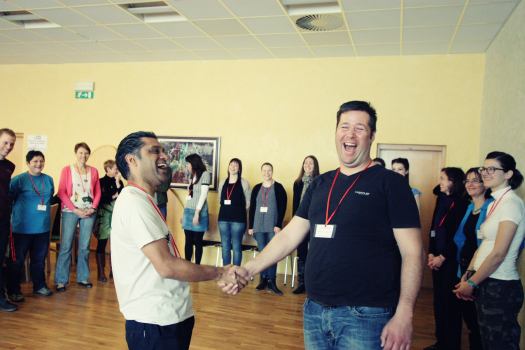
There are many reasons why laughter exercises could be used in the classroom. It is not simply a question of warming up the students, or making them feel positive. It is far deeper than that. Students often enter the room with a tired, lazy body language. That is understandable to some extent. If they are adults who’ve been working or studying all day, the last thing they want to do is sit down and listen to someone blabbering on in a language that’s already difficult to decipher. They need to get up and move and just 10-15 minutes of these exercises will completely change the atmosphere of the class. Children also have problems relating to energy and mood these days, thanks largely to their more static way of life.
Laughter has a strong link with emotion and so aids memory. Students and people in general remember information better if there is a link to humour or laughter. Therefore, laughter in all its forms should be a necessary part of teaching and learning.
As well as getting the blood circulating and creating endorphins, it opens up the creative, right side of the brain, stimulating ideas from within the student. This is not to be underestimated.
Once I’ve done a few minutes of laughter exercises, I can ask anything of my students and they will do it. All of those “outside the comfort zone” activities, which might provide embarrassment or inhibitions, go out the window once they’ve warmed up with these exercises. It becomes perfectly natural to ask a student to make strange facial expressions in front of another, or sing or dance, when normally they might well refuse.
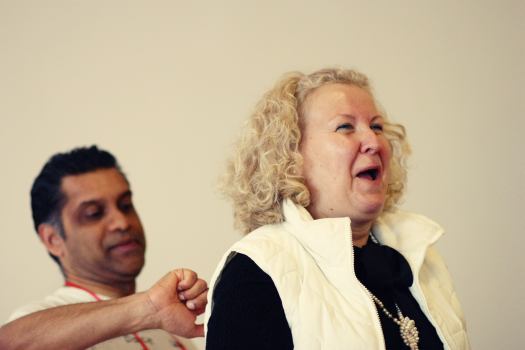
Laughter exercises help to build group dynamics and team building. It becomes difficult for a student to fight against another, once he/she has laughed together. It reduces inhibitions in a way which many would find unbelievable. Shy students are less so after a few sessions of laughter exercises and that more extrovert part of them comes out, thereby giving them greater self-confidence.
The strongest impact of laughter exercises on a learner is the first time. From then on, it gets easier!
Not all students initially take to it. Some look confused, having been trained to sit down, be quiet and listen to a teacher talk, they are now being asked to express themselves freely and to make a lot of noise. These exercises become an inherent part of my lessons, students expect these exercises every lesson and will complain if they don’t get them.
If a student isn’t laughing with enormous enthusiasm, there is no problem. Everyone is free to laugh in his/her own way. It may take a while for a person to release their natural laughter, but when it comes, it’ll be worth it. The fact that a person is not laughing out loud does not mean they are not enjoying the activity.
I have my own personal sense of humour, which I use in teaching as well as non-teaching activities. Humour is great when it works, however, as humour is personal, it doesn’t always work. Some people might not understand your humour due to language, or quite simply, they don’t appreciate your form of humour. Others might even be offended!
Laughter Yoga transcends all these barriers of language, culture, religion, since it is based on facial gestures, body language and movement rather than through the spoken word. It is physiological, working on the body before it gets to the mind. This makes it less rational and more emotional.
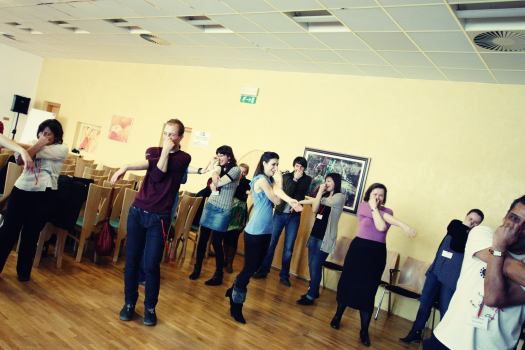
On one occasion, I had to make a very difficult decision, one which could have had serious consequences on my teaching career. I was invited to a school in the northeast of Italy to give some of my laughter exercises, creative and dynamic activities to middle and high School students. Each class presents its own challenges, but one in particular, gave me a situation that I could never have envisaged. One of the students in that class had been killed a few days earlier and all his classmates were in mourning. The teacher who had invited me suggested that it might be better to avoid laughter with that particular class as they wouldn’t really be in the mood for it. I agreed, but reflected on the fact that laughter yoga doesn’t require any thinking or brainwork. Hence, I went ahead with my original lesson plan. The only thing I did differently was that I didn’t ask the students how they felt. The results were shocking, even for me. All the students broke into fits of laughter and their teachers were left speechless, having not seen their pupils laugh for at least a week.
The amount of time you spend doing laughter exercises with your students in any one lesson is entirely up to you, how you feel, the time of day, how much other course material you have to fit into your lesson and how your students react.
If I’m doing a one-day or weekend workshop, there’ll be at least two hours of laughter exercises. However, in a normal one-hour or 90 minute lesson, the laughter exercises will generally be around ten to fifteen minutes.
As demonstrated in the workshop, we begin with correct breathing; in through the nose and out through the mouth. We then do the clapping mantra, ho ho, ha ha ha before the laughs begin. I almost always begin with the Welcome laugh, as it seems the most appropriate. The other laughs I use will vary according to how I feel, my students and a series of other factors. In the workshop in Slovenia, I demonstrated the Welcome laugh, the three versions of the Milkshake laugh, the Bee laugh, the Laughter Cream and the Elephant laugh. We then finished off with the Swing laugh which I often do, as it helps to unite the group.
Between each laugh, there is the ho ho, ha ha ha mantra which the teacher uses discretionally to choose the right moment to stop a particular laugh and move on to the next one. I’d also recommend some breathing between each laugh, as breathing is fundamental to almost every activity we do.
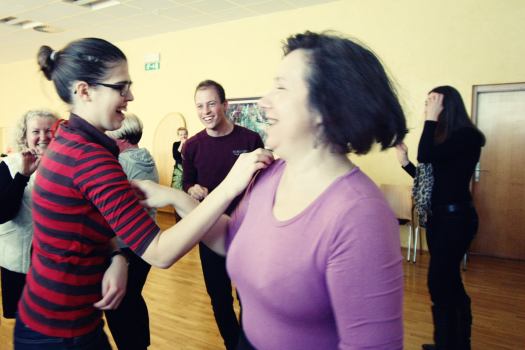
The eight or so laughs that I demonstrated in the workshop are more than enough to be getting on with, if you are going to use it as a 10-15 minute warm-up in your class. There are of course hundreds of different laughs which exist in laughter clubs all over the world. Ideally, if you enjoy this activity and see the benefits of it both in your teaching, as well as in your health and wellbeing, you should consider attending a local club in your area, thereby adding new laughs to your portfolio. If you have any difficulty finding a local club, feel free to contact me and I will help you.
After that, the next step would be to do a weekend training course in your country or even a one-week international training course. Apart from assimilating a number of laughs that you can use with different groups; kids, adults, businessmen and pensioners, you won’t know when to stop laughing.
Even if you decide to limit yourself to the same few laughs each time, neither you nor your students will become bored, as we respond to the laughs in different ways at different times. They are never exactly the same!
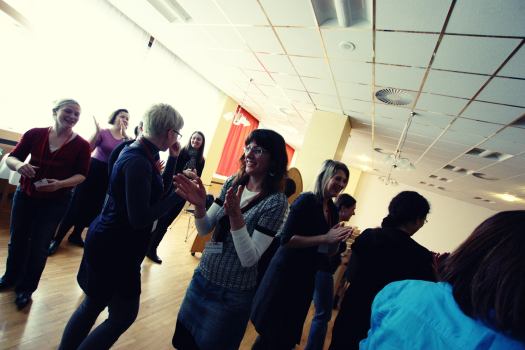
The first reason why I use laughter exercises in my lessons is to get the students moving, their blood flowing and their brains working. The consequences are that their inhibitions are reduced, their energy levels increased and they are willing to do more or less anything that I throw at them.
As the other activities that I use are often “outside the comfort zone” and physical, this gets them into the right frame of mind. Activities I use include; role-play, mime, voice work, singing, dancing, total physical response, drama, verb stretching, grammar massage, physical pronunciation and all kinds of games.
It should also be noted that I bring useful vocabulary and language into my laughs. When attending a typical laughter yoga session, a new laugh is demonstrated by a conductor and we then all do it together, with very little explanation needed. However, as this is first and foremost an English language lesson, I not only demonstrate the movements, but explain using spoken language. When introducing the elephant laugh, I explain that it has a very long memory, not to mention trunk. The bee laugh is introduced by explaining its useful purpose, to extract nectar or pollen from a flower, in order for me to have my bread and honey for breakfast. The laughter cream goes through most parts of the body before we eventually get to laugh. In this way, the students are not only having fun and increasing their learning potential, but they are really learning words at the same time, often without fully realising it.
This is the greatest activity for group dynamics that I have discovered so far and along with other team building games that I apply such as dancing, singing and circle work ensures that my students always enjoy working together in harmony.
I would love to hear from any teachers who decide to use laughter exercises in their lessons. If you have any feedback, or wish to have any further sessions on this subject, feel free to contact me.
I would recommend reading the following two articles on the same subject (which can be found and printed directly from my website) and consulting the following three websites.
Note that the third website is a WebTV in which you can see 14 (so far) short video lessons, A short taste of English, free ready-made video lessons to use with your classes.
Articles
Laughter Yoga in English Language teaching
old.hltmag.co.uk/aug08/mart02.htm
Laughter is a serious business
old.hltmag.co.uk/feb13/sart02.htm
Sites
www.laughnlearn.net
www.laughteryoga.org
www.inmagicartwebtv.eu

Please check the How the Motivate your Students course at Pilgrims website.
Please check the Building Positive Group Dynamics course at Pilgrims website.
Please check the Improving English through Humour course at Pilgrims website.


|